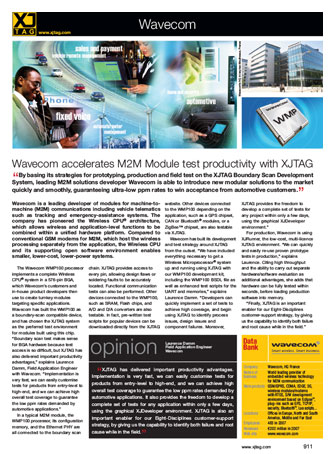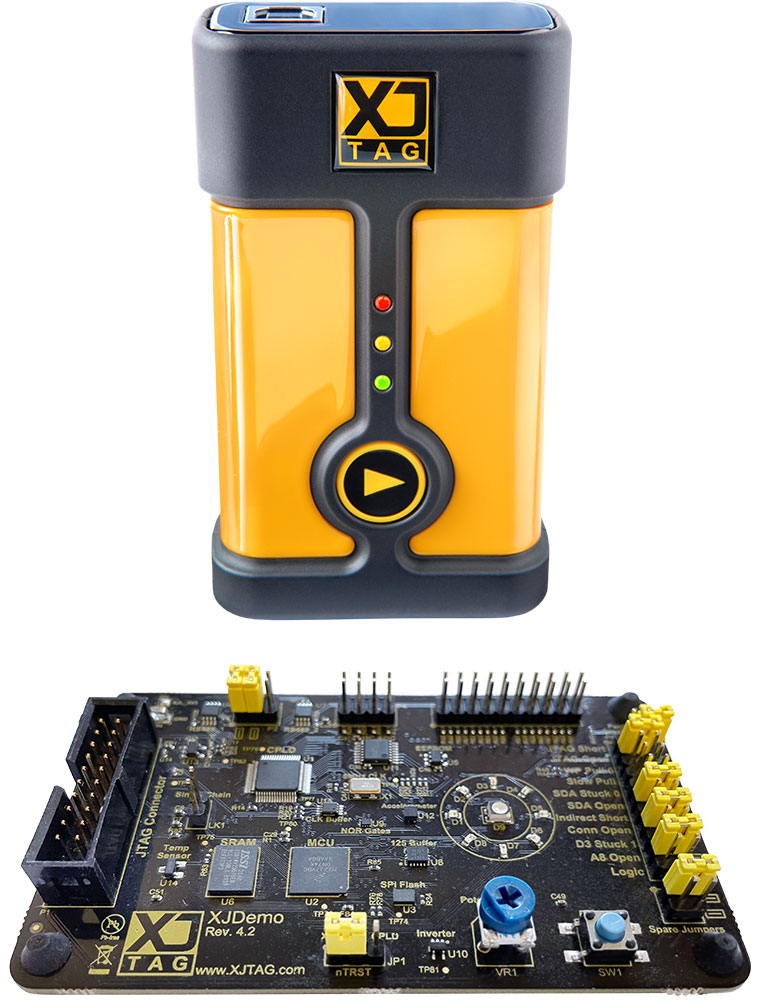
Wavecom accelerates M2M Module test productivity with XJTAG
By basing its strategies for prototyping, production and field test on the XJTAG Boundary Scan Development System, leading M2M solutions developer Wavecom is able to introduce new modular solutions to the market quickly and smoothly, guaranteeing ultra-low ppm rates to win acceptance from automotive customers.
Wavecom is a leading developer of modules for machine-to-machine (M2M) communications including vehicle telematics such as tracking and emergency-assistance systems. The company has pioneered the Wireless CPU® architecture, which allows wireless and application-level functions to be combined within a unified hardware platform. Compared to conventional GSM modems for M2M, which host the wireless processing separately from the application, the Wireless CPU and its supporting open software environment enables smaller, lower-cost, lower-power systems.
The Wavecom WMP100 processor implements a complete Wireless CPU® system in a 576-pin BGA, which Wavecom’s customers and in-house product developers then use to create turnkey modules targeting specific applications. Wavecom has built the WMP100 as a boundary-scan compatible device, and has chosen the XJTAG system as the preferred test environment for modules built using this chip. “Boundary scan test makes sense for BGA hardware because test access is so difficult, but XJTAG has also delivered important productivity advantages”, explains Laurence Damm, Field Application Engineer with Wavecom. “Implementation is very fast, we can easily customise tests for products from entry-level to high-end, and we can achieve high overall test coverage to guarantee the low ppm rates demanded by automotive applications.”
In a typical M2M module, the WMP100 processor, its configuration memory, and the Ethernet PHY are all connected to the boundary scan chain. XJTAG provides access to every pin, allowing design flaws or soldering faults to be accurately located. Functional communication tests can also be performed. Other devices connected to the WMP100, such as SRAM, Flash chips, and A/D and D/A converters are also testable. In fact, pre-written test scripts for popular devices can be downloaded directly from the XJTAG website. Other devices connected to the WMP100 depending on the application, such as a GPS chipset, CAN or Bluetooth® modules, or a ZigBee™ chipset, are also testable via XJTAG.
Wavecom has built its development and test strategy around XJTAG from the outset. “We have included everything necessary to get a Wireless Microprocessor® system up and running using XJTAG in our WMP100 development kit, including the WMP100 BSDL file as well as enhanced test scripts for the UART and memories”, explains Laurence Damm. “Developers can quickly implement a set of tests to achieve high coverage, and begin using XJTAG to identify process issues, design issues and component failures. Moreover, XJTAG provides the freedom to develop a complete set of tests for any project within only a few days, using the graphical XJDeveloper environment.”
For production, Wavecom is using XJRunner, the low-cost, multi-licence XJTAG environment. “We can quickly and easily re-use proven prototype tests in production,” explains Laurence. Citing high throughput and the ability to carry out separate hardware/software evaluation as additional advantages, she adds that hardware can be fully tested within seconds, before loading production software into memory.
“Finally, XJTAG is an important enabler for our Eight-Disciplines customer-support strategy, by giving us the capability to identify both failure and root cause while in the field.”

XJTAG has delivered important productivity advantages. Implementation is very fast, we can easily customise tests for products from entry-level to high-end, and we can achieve high overall test coverage to guarantee the low ppm rates demanded by automotive applications. It also provides the freedom to develop a complete set of tests for any application within only a few days, using the graphical XJDeveloper environment. XJTAG is also an important enabler for our Eight-Disciplines customer-support strategy, by giving us the capability to identify both failure and root cause while in the field.

Company: Wavecom, HQ France
Nature of business: World leading provider of embedded wireless technology for M2M communication
Main products: GSM/GPRS, CDMA, EDGE, 3G, wireless modules/modems with RTOS, S/W development environment based on Eclipse™, plug-ins such as GPS, TCP/IP, security, Bluetooth™, Lua scripts…
Locations: Offices in Europe, North and South America, Middle and Far East
Employees: 483 in 2007
Revenues: €202 million in 2007
Web site: www.wavecom.com

Configure your products














